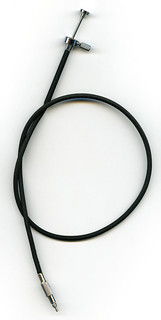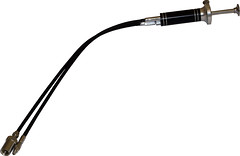Cable release
|
A cable release is an attachment that screws into a socket on a shutter release, allowing you to trip the shutter mechanically while being isolated from the camera - to reduce camera shake or to operate the camera from a distance. A cable release is especially useful for long exposures with the camera mounted on a tripod.
Most cable releases consist of a Bowden cable[1]: a flexible tube made from a spiral of metal wire covered in rubber or plastic, sometimes with a fabric outer sleeve. A steel cable runs through the tube, from a press-button at one end to a piston to press the release at the camera end. Some have an additional lock, to hold the shutter open for long time exposures. Some cable releases have 2 ends (double) and are used for macro photography in bellows and extension tubes to close the diaphragm while shooting.
The camera end of a cable release is most commonly threaded as shown in the picture on the right; with a short male thread that screws into a threaded socket in the camera's shutter release button (or on the barrel of a leaf shutter). When pressed, the cable pushes the linkage below the shutter button. A few cameras have a different attachment, with a threaded collar around the shutter button instead, and the cable ends in a wider, female thread. Some early Leica models have this, and the cable is often called a Leica cable release. Most Yashica TLRs also use this kind of attachment, with the male thread to accept the cable hidden by a removable knurled ring. Adapters exist that allow a standard cable release with this kind of shutter button.
An alternative remote shutter release is the pneumatic squeeze bulb—useful when the shutter must be released from a very great distance, where the internal friction of a cable-style release would be too high. A common criticism of pneumatic releases was the lack of tactile feedback when the bulb was squeezed, so that in a noisy environment, or if the camera was concealed for e.g. wildlife photography, it might not be obvious that the shutter had fired, or failed to fire.
The cable release has largely been replaced by electronic remote releases, which are more suited to electronic cameras, commonly operated wirelessly and communicating using infra-red light or Bluetooth.
|
| ||||
|
|




